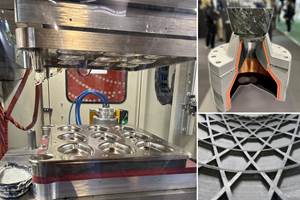Scalable powdered graphene amplifies composites manufacturing, molding
CAMX 2025: TMTP Labs introduces two novel products specifically developed for composites, TMTP-2430 and TMTP-3550 high-purity graphene powders.
Share

Source | TMTP Labs
(New Orleans, La., U.S.) introduces two novel, cost-effective and scalable, powdered graphene products for the composites industry. The products were developed to assist composites manufacturers, molders and solution providers to position new families of TMTP’s advanced products in industry.
TMTP-2430 is a high-purity, intact lattice, two-to-four-layer graphene powder with 30 µm flake sizes. It can be used in either functionalized or nonfunctionalized form depending on the customer’s product chemistry and manufacturing process needs. Typical uses are with epoxy resins, aerospace resins, carbon fiber, fiberglass composites and more. Typical loading percentages are 1% by final weight. Customer benefits may include improved tensile strength, impact strength, tensile modulus, durability, product life, thermal characteristics, conductivity, reduced weight and permeability, improved bacteriostatic performance and more.
TMTP-3550 is a high-purity, intact lattice, three-to-five-layer graphene powder with 50 µm flake sizes. Similarly to TMTP-2430, it can be used in a functionalized or nonfunctionalized form. Its typical uses are with cementitious materials and various forms of specialty cementitious blends. Typical loading percentages are 0.01-0.1% by dry weight. Customer benefits may include improved compression strength, flexural strength, durability, product life, conductivity, bacteriostatic performance and reduced permeability.
TMTP employs in-house and university-based advanced materials laboratories to provide integration and testing support for customer applications. The company also deploys application engineers to customer labs to support their own integration and validation of TMTP graphene in their proprietary formulations and processes.
Manufacturers of adhesives, coatings, elastomers, epoxies, fibers, paint, polymers, resins and nitrile rubber may find significant benefits through the adoption of TMTP graphene. End markets that may benefit include aerospace, automotive, construction, energy, marine, military, oil and gas, transportation, warehousing and others.
Related Content
-
Plant tour: Collins Aerospace, Riverside, Calif., U.S. and Almere, Netherlands
Composite Tier 1’s long history, acquisition of stamped parts pioneer Dutch Thermoplastic Components, advances roadmap for growth in thermoplastic composite parts.
-
JEC World 2024 highlights: Thermoplastic composites, CMC and novel processes
CW senior technical editor Ginger Gardiner discusses some of the developments and demonstrators shown at the industry’s largest composites exhibition and conference.
-
Bladder-assisted compression molding derivative produces complex, autoclave-quality automotive parts
HP Composites’ AirPower technology enables high-rate CFRP roof production with 50% energy savings for the Maserati MC20.
Related Content
Plant tour: Collins Aerospace, Riverside, Calif., U.S. and Almere, Netherlands
Composite Tier 1’s long history, acquisition of stamped parts pioneer Dutch Thermoplastic Components, advances roadmap for growth in thermoplastic composite parts.
Read MoreJEC World 2024 highlights: Thermoplastic composites, CMC and novel processes
CW senior technical editor Ginger Gardiner discusses some of the developments and demonstrators shown at the industry’s largest composites exhibition and conference.
Read MoreBladder-assisted compression molding derivative produces complex, autoclave-quality automotive parts
HP Composites’ AirPower technology enables high-rate CFRP roof production with 50% energy savings for the Maserati MC20.
Read MoreThe potential for thermoplastic composite nacelles
Collins Aerospace draws on global team, decades of experience to demonstrate large, curved AFP and welded structures for the next generation of aircraft.
Read MoreRead Next
Louisiana graphene startup reports R&D partnership, test results
TMTP’s graphene is reported to improve the tensile strength of epoxy by more than 400%, produced via a scalable, low-energy process. The company is targeting applications in composites, plastics and 3D printing.
Read MoreHydroGraph ramps up efforts to scale pristine graphene offerings
Purchase orders for autocomposite improvement program, patent application filings and additional certifications push the graphene producer on its path forward to commercialization for composites, coatings and lubricants, to name a few.
Read MoreCeramic matrix composites: Faster, cheaper, higher temperature
New players proliferate, increasing CMC materials and manufacturing capacity, novel processes and automation to meet demand for higher part volumes and performance.
Read More









